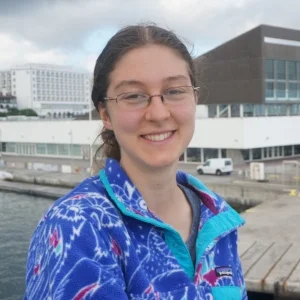The Story Collider is partnering with the American Geophysical Union for this FREE show in conjunction with its fall meeting! Join us for five stories about the Earth and space sciences.
Hosted by Shane Hanlon and Erin Barker. Full lineup to be announced soon.
Doors open at 6:30 pm. Show starts at 7 pm.
Reserve your FREE spot at the show here:
Stories by:
Kim Cobb is a researcher who uses corals and cave stalagmites to probe the mechanisms of past, present, and future climate change. Kim has sailed on multiple oceanographic cruises to the deep tropics and led caving expeditions to the rainforests of Borneo in support of her research. Kim has received numerous awards for her research, most notably a NSF CAREER Award in 2007, and a Presidential Early Career Award for Scientists and Engineers in 2008. She is an Editor for Geophysical Research Letters, sits on the international CLIVAR Pacific Panel, and serves on the Advisory Council for the AAAS Leshner Institute for Public Engagement. As a mother to four, Kim is a strong advocate for women in science, and champions diversity and inclusion in all that she does. She is also devoted to the clear and frequent communication of climate change to the public through speaking engagements and social media.
Julia Kumari Drapkin is the CEO and founder of ISeeChange, an award-winning citizen journalism and citizen science venture that empowers communities to connect to each other and their changing environment. Drapkin created ISeeChange after spending over a decade reporting natural disasters and climate change science stories across the globe and in her own backyard. Drapkin currently serves on the board of the National Federation of Community Broadcasters and is a consultant for the think tank Resources for the Future and NASA.
Don Hood is a PhD student at Louisiana State University, he studies planetary science in the department of Geology and Geophysics. His love of geology goes back to childhood, despite growing up near the muddy waters of Buffalo Bayou in Houston where rocks are few and far between. After getting a B.S. in physics from Carnegie Mellon University in 2014, he pursued planetary science for his PhD and hasn’t looked back since. He studies the surface of Mars with a variety of remote-sensing techniques, exploring the geochemistry of surface soils and the migration of boulders in the northern plains. He is also an avid player of board games and homebrewer, preferably doing both when possible.
Hannah Mark is a PhD student in marine geophysics in the MIT-WHOI Joint Program in Oceanography. She started out studying theoretical physics as an undergrad at the University of Chicago, but soon realized that applying physics to very large rocks was a lot of fun and slid over into geoscience. Now, she uses active-source seismic data and numerical models (ie, sound waves and computers) to study plate tectonics. She also sings in a choir, quilts, and carries a wallet-size card of the geologic timescale at all times, just in case.
Sarah Myhre Ph.D. is a Research Associate at the University of Washington and a board member of both 500 Women Scientists and the Center for Women and Democracy. She is actively investigating and publishing on the paleoceanographic history of the Pacific ocean, using ocean sediment cores and robots on the seafloor. She is a freelance writer, grass roots organizer, and a leading voice in the field science communication. She is also an uncompromising advocate for women's voices and leadership, both in science and society.




